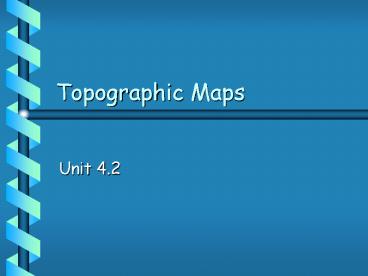Topographic Maps - PowerPoint PPT Presentation
1 / 8
Title:
Topographic Maps
Description:
Topo map Since the 1600s, ... the U.S. Geological Survey ... The contour lines of a depression make a small circle the shape of the depression, ... – PowerPoint PPT presentation
Number of Views:171
Avg rating:3.0/5.0
Title: Topographic Maps
1
Topographic Maps
- Unit 4.2
2
Types of Maps
- Climate maps give general information about the
climate and precipitation of a region.
Cartographers use colors to show different
climate or precipitation zones. - Economic or resource maps feature the type of
natural resources or economic activity that
dominates an area. - Physical maps illustrate the physical features of
an area, such as the mountains, rivers and lakes.
3
Types of Mapscont.
- Political maps do not show physical features.
Instead, they indicate state and national
boundaries and capital and major cities. - Road maps show major roads, airports, railroad
tracks, cities and other points of interest in an
area. - Topographic maps include contour lines to show
the shape and elevation of an area. Lines that
are close together indicate steep terrain, and
lines that are far apart indicate flat terrain.
4
Topo map
- Since the 1600s, topographic mapping has become
an integral part of a country's cartography. - These maps (topo maps for short) remain among the
most valuable maps for government the public
alike. - In the United States, the U.S. Geological Survey
(USGS) is responsible for topographic mapping.
5
More about topos
- The USGS' primary scale for mapping topographic
maps is 124,000. This means that one inch on the
map equals 24,000 inches on the ground, the
equivalent of 2000 feet.
6
How to read a Topo map
- When contour lines lie close together they
represent a steep slope - When contour lines lie far apart they represent a
gradual slope.
- Topographic maps use a wide variety of symbols to
represent human and physical features. - Contour lines are used to represent elevation by
connecting points of equal elevation.
7
Looking at Contour Lines
8
A look at some topo maps...
Marshy areas are shown as small clumps of blue
reeds along with intermittent blue lines.
Depending on how much water is present, the marsh
symbols may or may not be located in water.
A body of water, such as a lake or pond, is drawn
to the correct shape and scale of the actual body
of water. The entire body of water is blue. The
name of the body of water will either be on the
blue or nearby.
A HILL is a terrain feature that has low ground
on all four sides. It is shown on a map as a
series of circular contour lines. The center of
the smallest circular contour line is considered
the hilltop.
The contour lines of a depression make a small
circle the shape of the depression, but the
difference between a depression and a hilltop is
that the small circle of the depression will have
small tick marks pointing toward the center of
the circle, showing that this is "down" into the
depression.
A large river's course is drawn to scale, as is
its width, and is entirely in blue. The name of
the river will me placed along side the river at
regular intervals. If the river is too narrow to
depict to scale on the map, then the river is a
solid blue line.
Man-made structures are shown as small black
square (for most house size structures) or
odd-shaped black structures, if a discernable
shape can be made on the map. Buildings that are
ruins or shells are shown as small hollow
squares.































